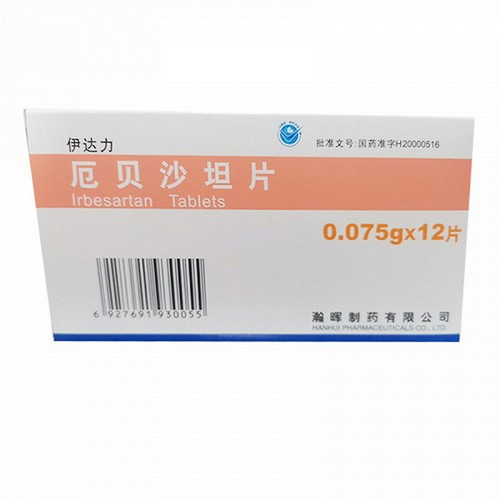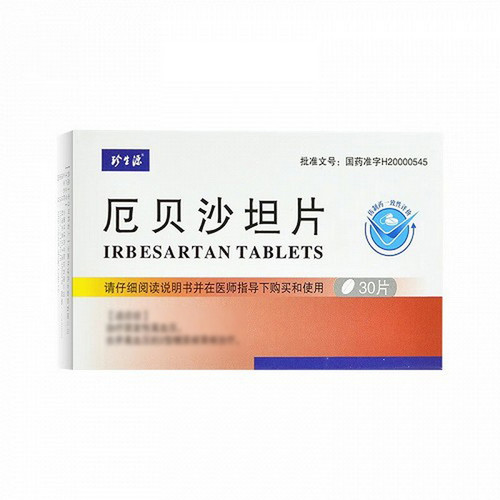Product Overview
[Drug Name]
Generic Name: Irbesartan Tablets
Trade Name: RuoPeng Irbesartan Tablets 0.075g*1*12 Tablets/Plate
Pinyin Code: RuoPeng EBeiShaTanPian 0.075g*1*12 Tablets/Plate
[Main Ingredient]
The main ingredient of this product is irbesartan. Chemical Name: 2-Butyl-3-{4-{2-(1H-tetrazol-5-yl)phenyl]benzyl]-1,3-diazaspiro-[4.4]wang-1-en-4-one. Molecular Formula: C25H28N60. Molecular Weight: 428.54
[Properties]
This product is a film-coated tablet that appears white or off-white after removal of the coating.
[Indications/Main Functions]
Treatment of essential hypertension. Treatment of type 2 diabetic nephropathy associated with hypertension.
[Specifications]
0.075g*1*12 tablets/plate (Ruopeng)
[Dosage and Administration]
Oral: The recommended starting dose is 0.15g once daily. The dose can be increased to 0.3g once daily depending on the condition. It can be used alone or in combination with other antihypertensive medications. For severe hypertension or when blood pressure remains unsatisfactory after increasing the dose, a small dose of a diuretic (such as a thiazide) or other antihypertensive medication can be added.
[Adverse Reactions]
Common adverse reactions include headache, dizziness, palpitations, and occasional cough. These are generally mild and transient, and most patients can tolerate continued medication. Urticaria and angioedema are rare. Literature reports of adverse reactions with an incidence greater than 1% for this product include: indigestion, heartburn, diarrhea, skeletal muscle pain, fatigue, and upper respiratory tract infection, but these reactions were not significantly different from the control group. Symptoms occurring in >1% of patients but less frequently than in the control group include abdominal pain, anxiety, nervousness, chest pain, pharyngitis, nausea and vomiting, rash, and tachycardia. The incidence of hypotension and orthostatic hypotension is approximately 0.4%.
[Contraindications]
This product is contraindicated in patients with allergies.
[Drug Interactions]
1. When using this product with diuretics, caution should be exercised regarding hypovolemia or hyponatremia, which may result in hypotension. When used with potassium-sparing diuretics (such as triamterene), elevated serum potassium should be avoided.
2. This product has no significant interaction with warfarin.
3. Concomitant use with digitalis drugs such as digoxin, beta-blockers such as atenolol, and calcium antagonists such as nifedipine does not affect the pharmacokinetics of these drugs.
[Precautions]
1. Correct hypovolemia and/or sodium depletion before initiating treatment. 2. Patients with renal insufficiency may require a reduced dose of this product. Furthermore, changes in blood urea nitrogen, serum creatinine, and serum potassium should be monitored. As a result of renin-angiotensin-aldosterone inhibition, some sensitive patients may experience changes in renal function. 3. No dosage adjustment is required for patients with hepatic impairment or the elderly. 4. Irbesartan cannot be excreted through hemodialysis.
[Pediatric Use]
No safety data are available for patients under 18 years of age.
[Elderly Use]
Not yet established.
[Overdose]
Overdose with this drug may cause hypotension, tachycardia, or bradycardia. Induce emesis, gastric lavage, and supportive care should be employed.
[Pharmacology and Toxicology]
This drug is an angiotensin II (Ang II) receptor inhibitor that inhibits the conversion of Ang I to Ang II. It specifically antagonizes the angiotensin-converting enzyme 1 (AT1) receptor, with an antagonistic effect greater than 28,500 times that of AT1. By selectively blocking the binding of Ang II to the AT1 receptor, it inhibits vasoconstriction and aldosterone release, resulting in a hypotensive effect. This product does not inhibit angiotensin-converting enzyme (ACE), renin, or other hormone receptors, nor does it inhibit ion channels involved in blood pressure regulation and sodium homeostasis.







